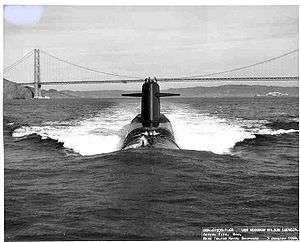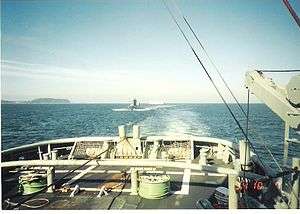USS Woodrow Wilson (SSBN-624)
 USS Woodrow Wilson (SSBN-624) in San Francisco | |
| History | |
|---|---|
| Name: | USS Woodrow Wilson |
| Namesake: | Woodrow Wilson (1856–1924), 28th President of the United States (1913–1921) |
| Ordered: | 9 February 1961 |
| Awarded: | 9 February 1961 |
| Builder: | Mare Island Naval Shipyard, Vallejo, California |
| Laid down: | 13 September 1961 |
| Launched: | 22 February 1963 |
| Sponsored by: | Miss Eleanor Axson Sayre, Wilson's Granddaughter |
| Commissioned: | 27 December 1963 |
| Decommissioned: | 1 September 1994 |
| Reclassified: | Attack submarine (SSN-624) in 1990 |
| Struck: | 1 September 1994 |
| Fate: | Recycled via Ship-Submarine Recycling Program 26 September 1997 through 27 October 1998 |
| Status: | Recycled |
| General characteristics | |
| Class and type: | Lafayette-class submarine |
| Type: | Ballistic missile submarine (hull design SCB-216)[1] |
| Displacement: |
|
| Length: | 425 ft (130 m) |
| Beam: | 33 ft (10 m) |
| Draft: | 31 ft 6 in (9.60 m) |
| Propulsion: |
|
| Speed: |
|
| Complement: | Two crews (Blue Crew and Gold), 13 officers and 130 enlisted each |
| Sensors and processing systems: | BQS-4 sonar[1] |
| Armament: |
|
USS Woodrow Wilson (SSBN-624), a Lafayette class ballistic missile submarine, was the only ship of the United States Navy to be named for Woodrow Wilson (1856–1924), the 28th President of the United States (1913–1921). She later was converted into an attack submarine and redesignated SSN-624.
Construction and commissioning
The contract to build Woodrow Wilson was awarded to Mare Island Naval Shipyard at Vallejo, California, on 9 February 1961 and her keel was laid down there on 13 September 1961. She was launched on 22 February 1963 sponsored by Miss Eleanor Axson Sayre (Wilson's granddaughter), and commissioned on 27 December 1963, with Commander Cleo N. Mitchell in command of the Blue Crew and Commander Walter N. Dietzen in command of the Gold Crew.
Operational history
Woodrow Wilson departed Mare Island Naval Shipyard on 9 January 1964, bound for the United States East Coast. After stopping briefly at San Diego, she proceeded on to the Panama Canal, arriving on 19 January 1964 at its western end. Violent anti-American demonstrations and riots over a recent flag-displaying incident had resulted in an extremely tense atmosphere. As a result, she transited the canal in a record seven hours ten minutes while combat-ready United States Marines and United States Army soldiers guarded the locks.
Making port at Charleston, South Carolina, on 5 February 1964, Woodrow Wilson conducted a shakedown cruise off the lower U.S. East Coast into March 1964 and underwent post-shakedown repairs and alterations into April 1964. She put to sea at the end of May 1964 upon the conclusion of these repairs and alterations and commenced her first deterrent patrol out of Charleston in June 1964.
Woodrow Wilson subsequently operated in the Atlantic Ocean until the autumn of 1968, conducting patrols from forward bases at Rota, Spain and Holy Loch, Scotland. After undergoing a 13-month overhaul and conversion to the Polaris A3 ballistic missile at Newport News Shipbuilding, she was transferred to the United States Pacific Fleet via Charleston and the Panama Canal, arriving at Pearl Harbor, Hawaii, on 19 November 1969. She then continued on to the western Pacific Ocean, was based at Guam, and conducted deterrent patrols from Apra Harbor through 1972.
In 1972, Woodrow Wilson shifted back to the Atlantic and another overhaul and conversion to the Poseidon C3 missile at Newport News Shipbuilding. She was then home-ported at Charleston for operations with the United States Atlantic Fleet.
On 4 June 1979, Woodrow Wilson ran aground in heavy fog at Race Rock while en route to New London, Connecticut. The submarine was able to free itself and proceed to port for inspection of the damage.
After several overhauls in Charleston Naval Shipyard at Charleston and 40 more deterrent patrols, Woodrow Wilson was converted into an attack submarine and redesignated SSN-624 in 1990. Between 1964 and 1987 she had completed 71 successful strategic deterrent patrols.
In her new role, between 1990 and 1993 Woodrow Wilson completed a series of special operations patrols.
Decommissioning and disposal
_underway.jpeg)

Woodrow Wilson was deactivated in September 1993. She was decommissioned on 1 September 1994 and stricken from the Naval Vessel Register the same day. Ex-Woodrow Wilson entered the Nuclear Powered Ship and Submarine Recycling Program at Bremerton, Washington, on 26 September 1997. Recycling of Ex-Woodrow Wilson was completed on 27 October 1998.
Commemoration
Woodrow Wilson's sail is preserved as part of the Deterrent Park monument at Naval Base Kitsap in Bangor, Washington.[3] [4]
References
- 1 2 3 4 Adcock, Al (1993). U.S. Ballistic Missile Submarines. Carrolltown, Texas: Squadron Signal. p. 22.
- ↑ "USS Salvor Command History 1994" (pdf). p. 4. Retrieved 2011-09-24.
- ↑ "USSVI: Washington State Memorials". USSVI. Retrieved 2011-09-24.
- ↑ "Deterrent Park, Bangor, Washington". USSVI. Archived 5 July 2007 at the Wayback Machine.
- This article incorporates text from the public domain Dictionary of American Naval Fighting Ships. The entry can be found here.
- This article includes information collected from the Naval Vessel Register, which, as a U.S. government publication, is in the public domain. The entry can be found here.
External links
- USS Woodrow Wilson (SSBN-624) Association
- Photo gallery of USS Woodrow Wilson (SSBN 624) Keel Laying – Launching at NavSource Naval History
- Photo gallery of USS Woodrow Wilson (SSBN 624) Commissioning at NavSource Naval History
- Photo gallery of USS Woodrow Wilson (SSBN 624) Active Service – Present at NavSource Naval History